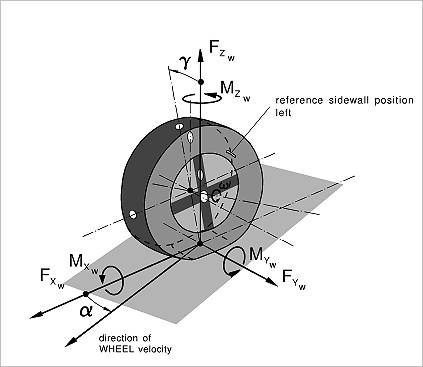
Axis systems
The MF-Tire/MF-Swift 6.1 uses the ISO sign conventions as shown in the Figure below.

Figure 1 ISO sign conventions
The longitudinal slip  and sideslip angle are defined
as:
and sideslip angle are defined
as:
 (note:
κ=−1 is braking
at wheel lock),
(note:
κ=−1 is braking
at wheel lock),

In these equations Vx is the x-component (in the wheel centre plane) of the wheel contact centre.
horizontal (i.e. parallel to road) velocity V; Vs is the wheel slip velocity, with components Vsx and Vsy, which is defined as the horizontal velocity of the slip point that is thought to be attached to the wheel at a distance that equals the effective rolling radius below the wheel centre in the wheel centre plane.
Units
The output of tire model is always in SI units (m, N, rad, kg, s).
The tire property file uses SI units by default (m, N, rad, kg, s)
•This is always the case when it is generated by MF-Tool.
•It is allowed to use a different set of units (e.g. mm or inch for length).
•The specification in the [UNITS] section file applies to all parameters in the tire property file.
•The tire model expects SI units to be passed via the interface between tire model and the multibody simulation program, as defined in the specification of the Standard Tire Interface (STI) [8].
•However, many multibody codes do not use units internally and leave the choice of a consistent set of units to the user.
•In many cases, this implies that the vehicle model has to be defined using SI units to avoid unit conversion problems.
•Please contact TNO if the user has the special, non-standard requirements with respect to units.